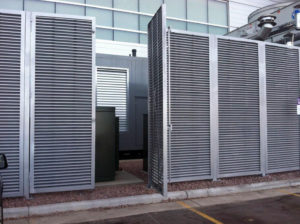How to Choose your Gate
Choosing the correct architectural screen fencing and wall gate for you and your property is important, and can be easy with the help of this guide. To start out with, there are two basic types of gates that can be easily automated: swing gates and cantilever slide gates. All of these gate are available in both architectural screen fencing and wall or mechanical equipment louvered screening.
AUTOMATED SLIDE GATES

Commercial slide, rolling or cantilever gates are common because reliability and security are at the forefront of their requirements. Commercial and industrial slide gates are usually installed with only a single leaf, but it is possible to have a double drive sliding gate as well. You should consider the following information if you’re considering getting a slide gate for your commercial, residential or industrial property.
Gate Storage
Due to storage needs, commercial cantilever, rolling or slide gates are usually about 50% larger than the gate opening. If you have a 20’ gate opening then you would need a 30’ overall slide gate. The extra 10’ is known as the counter balance and also lets your slide gate easily attach to the gate operator. All slide gates are available in architectural screen fencing and wall or mechanical equipment louvered screening.
Elevation
If slide gates are not installed level in accordance with ASTM F 2200, it can cause significant injury from sliding under its own weight. As this is a requirement, you should measure the ground’s elevations the entire length that the cantilever gate will travel, and the gate will be set a couple inches above the highest elevation. If the tail of the cantilever gate happens to have the highest elevation, then the gate could end up being raised a significant distance off the ground at the opening.
AUTOMATED SWING GATES
When it comes to residential properties, swing gates are generally the most popular. Home owners prefer the look of the gate swinging open to welcome them home. Swing gates come in both single and double swings. Before you commit to an automatic swing gate, take the following points into consideration.
Swing In or Out

Your automated swing gates can swing in our out, but a majority of swing gates swing out. This is true because most driveways slope downward, from the house to the street. Swing gates must remain level as they open, so if the gate is swinging in, it may scrape the driveway before it can open all the way up. However, opening outward may be a problem if your space from the street to the gate is small. Account for room for at least two car lengths, as unsuspecting visitors often will back up when they see the gate swing outward. If you don’t leave enough room, visitors may back up into oncoming traffic. All of our swing gates are available in all of our architectural infills or mechanical equipment louvered infills.
Single or Double Swing Gate
A major difference between the single and double swing gates is that single swing gates only require one gate operator whereas double swing gates need two gate operators that communicate with each other. Double swing gates have a much shorter swing, so even though the cost of two gate operators is more expensive there are many benefits to this option. Double swing gates are available in both our architectural screen fencing and wall and louvered screening options.
- Most driveway swing gates swing outward, and in these cases it can be a lot less startling to guests if two smaller leaves open out toward them rather than one large one. This being said, guests who are not used to your gate are much less likely to back out of your driveway into traffic when your gate begins to open.
- A singular, large gate leaf would probably require a larger gate operator whereas a double swing gate would use two smaller operators powering separate leaves. Automated double swing gates can also act as snow plows in the winter time, but a larger single gate might struggle to push aside even a few inches of snow.
Elevation
You need to consider the elevation of your land when considering a residential or commercial swing gate. If you have a single swing gate that is 16’, then that means it will cover 16’ of the driveway from a closed position to an open position.
If the driveway varies at all in slope, the gate leaf could scrape against your driveway or parking lot, or leave an unseemly gap underneath the gate leaf when closed. If you have two 8’ gate leaves instead of one 16’ leaf, the risk of gaps or scraping are reduced.
You should figure out the elevations of your parking lot or driveway in the entire area that the gate will operate. Whatever the highest elevation is will be your benchmark. The gate will then be installed a few inches above this elevation.
ADDITIONAL CONSIDERATIONS
The Secure Option
Slide gates tend to be more secure than swing gates. Industrial swing gates may be easily pried open if not set up with a magnet or electric mechanical lock, allowing someone to squeeze through the gate leaves. Industrial slide gates can be very difficult to pry open as they are often set up with a receiver that lets the gate slide into a receiver post.
Swing of the Gate
Both single and double swing gates cover quite a bit of ground when they open and close. You have to be mindful that the span of the commercial swing does not interfere with parked cars, traffic lanes, surrounding structures, etc. Several swing gate operators store your gate leaves against the fence line by opening up a full 180 degrees. This is good news as long as there are no obstacles that could get in this area such as parked cars or trash cans.
Overall Reliability
Basic physics tells us that commercial swing gates are often just not as reliable as commercial slide gates. Automated slide gates don’t have to put up with less wind resistance and fewer difficulties from snow. Slide gates have the advantage of moving along a simple line where as swing gates must push through a much larger area span with its leaf or leaves. Commercial and industrial swing gates will struggle after a large snowfall to push through the pile of snow that accumulates around its leaves whereas commercial and industrial slide gates can cut through the snow with ease. When swing gates encounter this kind of resistance it can even register to the gate operator as a foreign object and cause it to go into a “safe mode.”
GATE STYLE

Once you have decided whether you want a swing or slide gate, it is time to choose your gate style. Industrial cantilever and swing gates can both have a basic design of chain link mesh and galvanized framework, or they can be beautiful ornamental gates with decorative rings, pickets, letters, finials and custom designs.
While there is no limit to our ability to create unique and interesting gate designs, you need to be aware that the design plays a big role in the overall weight and size of the gate. Weight and size are key factors when it comes to choosing a gate operator.
GATE SAFETY GUIDELINES
You need to be sure your gate design is in accordance with ASTM F 2200 and UL 325L to avoid any unsafe or hazardous gates:
- Gates should have a positive stop at the full open position
- No gate receiver hardware should protrude out into the opening
- All gates should have a smooth bottom with no pickets protruding
- Slide gates should not have openings greater than 2 ¼” in the gate
- All gates should be prevented from falling if disconnected from the gate hardware
- Swing gates should not create an entrapment area less than 16” when swinging open
- The area between the post to the hinge point of a swing gate should not be greater than 4”
- The gate should not have any obstruction or design component protruding out from the gate that may create a hazard below 8’
